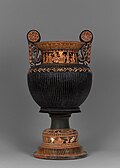File:Attic red-figure dinoid volute krater and stand by Meleager Painter, side A - Getty Museum (87.AE.93).jpg

File originale (4 785 × 6 687 pixel, dimensione del file: 4,1 MB, tipo MIME: image/jpeg)
| Questo file e la sua pagina di descrizione (discussione · modifica) si trovano su Wikimedia Commons (?) |
Dettagli
Oggetto
| Pittore di Meleagro: Attic red-figure dinoid volute krater and stand
|
|||||||||||||||||||||||||||
|---|---|---|---|---|---|---|---|---|---|---|---|---|---|---|---|---|---|---|---|---|---|---|---|---|---|---|---|
| Artista |
|
||||||||||||||||||||||||||
| Titolo | |||||||||||||||||||||||||||
| Tipo di oggetto |
cratere / arte greca |
||||||||||||||||||||||||||
| Descrizione |
|
||||||||||||||||||||||||||
| Persone ritratte | |||||||||||||||||||||||||||
| Data |
tra il 390 e il 380 a.C. date QS:P,-350-00-00T00:00:00Z/7,P1319,-0390-00-00T00:00:00Z/9,P1326,-0380-00-00T00:00:00Z/9 |
||||||||||||||||||||||||||
| Tecnica/materiale |
terracotta |
||||||||||||||||||||||||||
| Dimensioni |
altezza: 78,7 cm dimensions QS:P2048,+78.7U174728 dimensions QS:P2386,+40.6U174728 |
||||||||||||||||||||||||||
| Collezione |
institution QS:P195,Q180401 |
||||||||||||||||||||||||||
| Ubicazione attuale | |||||||||||||||||||||||||||
| Numero d'inventario |
87.AE.93 (Getty Museum) |
||||||||||||||||||||||||||
| Riferimenti | |||||||||||||||||||||||||||
Fotografia
| DescrizioneAttic red-figure dinoid volute krater and stand by Meleager Painter, side A - Getty Museum (87.AE.93).jpg | ||||
| Fonte |
The Getty Center, Object 103WFJ
|
|||
| Autore | Getty Museum | |||
| Licenza (Riusare questo file) |
|
|||
| Altre versioni |
|
Didascalie
Elementi ritratti in questo file
raffigura
Cronologia del file
Fare clic su un gruppo data/ora per vedere il file come si presentava nel momento indicato.
| Data/Ora | Miniatura | Dimensioni | Utente | Commento | |
|---|---|---|---|---|---|
| attuale | 01:48, 19 mar 2024 |  | 4 785 × 6 687 (4,1 MB) | DEGA MD | Uploaded a work by The J. Paul Getty Museum from getty.edu with UploadWizard |
Pagine che usano questo file
La seguente pagina usa questo file:
Utilizzo globale del file
Anche i seguenti wiki usano questo file:
- Usato nelle seguenti pagine di www.wikidata.org:
Metadati
Questo file contiene informazioni aggiuntive, probabilmente aggiunte dalla fotocamera o dallo scanner usati per crearlo o digitalizzarlo. Se il file è stato modificato, alcuni dettagli potrebbero non corrispondere alla realtà.
| Autore | The J. Paul Getty Museum |
|---|---|
| Descrizione dell'immagine |
|
| Titolo breve |
|
| Crediti | The J. Paul Getty Museum, Villa Collection, Malibu, California |
| Fonte | The J. Paul Getty Museum |
| Termini di utilizzo | |
| Dichiarazione online di copyright | http://www.getty.edu/legal/copyright.html |
| Commento del file JPEG | Generated by IIPImage |
| Informazioni di contatto | rights@getty.edu
www.getty.edu 1200 Getty Center Drive Los Angeles, California, 90049 United States |
| Data in cui i metadata sono stati modificati l'ultima volta | 00:29, 14 feb 2020 |
| Informazioni sul copyright | Status del copyright non impostato |


























